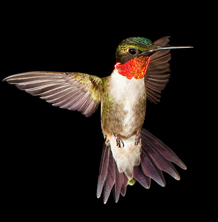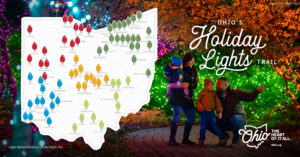Hummingbirds are a favorite summertime visitor

The Ruby-Throated Hummingbird weighs less than an ounce. Photo from the ODNR.
 One of the most-loved birds in our area, and everywhere actually, is the hummingbird.
One of the most-loved birds in our area, and everywhere actually, is the hummingbird.
There are over 300 different species of hummingbirds around the world, and dozens of species in North America, but here in Ohio and West Virginia the most common is the Ruby-Throated Hummingbird, or Archilochus colubris. When someone says “hummingbird,” that’s the species that comes to mind.
The Ruby-Throated Hummingbird weighs less than an ounce, and if you have ever watched them in action you know that they can fly forwards, backwards, and hover in midair, then zip away just as quickly as they appeared – they can reportedly fly as fast as 60 miles an hour. Hummingbirds are the only bird species that can fly backwards.
To me one hummingbird pretty much looks like another; they move too fast for my eyes to discern much in the way of details, but I do enjoy watching them flying about, usually announced by the humming sound which gives them their name.
According to the Ohio Division of Wildlife, the Ruby-Throated Hummingbird nests in trees, generally those at the edge of the woods or other openings, such as along a wooded stream side. If you are able to locate the tiny nest, which is the size of half an English walnut shell, you may well find nests in the same area in future years.
Hummingbirds are polygamous breeders, meaning they do not form pairs that mate for life. Peak breeding activity occurs in June and July, and young are hatched in the same months, as the two eggs are only incubated for 14-16 days. The young leave the nest just 20-22 day after hatching. Usually two broods are produced in a year.
Ruby-Throated Hummingbirds spend the summer in eastern North America including well up into Canada, in the fall they migrate south to Central America, as far south as Panama, and some even make the non-stop, 20-hour, 900-mile flight across the Gulf of Mexico.
Nobody doesn’t like hummingbirds. Which is convenient because the hummingbird is one species that can definitely benefit from the presence of humans, especially humans who plant nectar-rich flowering species or put out hummingbird feeders.
Every fall I get several phone calls about when people should put out or take down their hummingbird feeders; a general rule of thumb for our area is put them out by tax day (April 15) and leave them up until the middle of October, or about two weeks after you see the last one.
Some people think that keeping your feeders out will prevent the hummingbirds from migrating south, that isn’t the case, in fact they need that nectar for the trip. My advice is to not be in a hurry to take them down, just keep an eye on your feeders and when they stop coming, give them another week or two, then take them down. Also, don’t use the colored hummingbird nectar; sugar water with one part sugar to four or five parts of water will work just fine.
Gardeners can also plant flowers that hummingbirds like; generally red, orange or bright pink tubular flowers are great sources of nectar for hummingbirds.
Did you know that hummingbirds don’t only drink nectar? They also eat small insects they catch on flowers or in the air – those ants at your hummingbird feeder can also be hummingbird snacks.
Even as small and fast as they are, they do have predators. Hummingbird predators include domestic and feral cats, accidental car strikes, Sharp-Shinned Hawks, even praying mantises and large fish, and sometimes even plants like cockleburs. Of course snakes and other critters can rob hummingbird nests.
A wildlife urban legend states that Ruby-Throated Hummingbirds ride on the backs of geese during migration while another one claims that they don’t have feet! Other people think their bills are like hollow straws while they are actually just long, thin bills.
In short, there are plenty of wonderful things to know about hummingbirds without having to make things up.
Jim Freeman is the wildlife specialist for the Meigs Soil and Water Conservation District. He can be contacted weekdays at 740-992-4282 or at [email protected]







